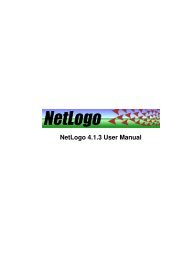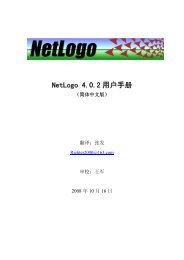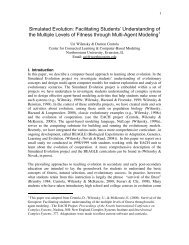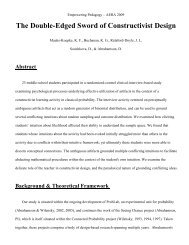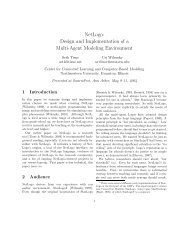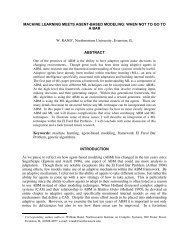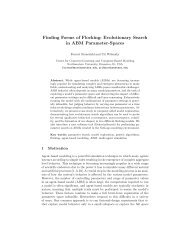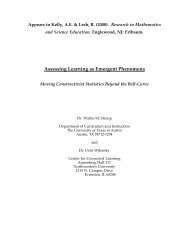Design Guidelines for Agent Based Model Visualization
Design Guidelines for Agent Based Model Visualization
Design Guidelines for Agent Based Model Visualization
You also want an ePaper? Increase the reach of your titles
YUMPU automatically turns print PDFs into web optimized ePapers that Google loves.
<strong>Design</strong> <strong>Guidelines</strong> <strong>for</strong> <strong>Agent</strong> <strong>Based</strong> <strong>Model</strong> <strong>Visualization</strong><br />
5.1<br />
5.2<br />
Emergent patterns with<br />
mobile agents<br />
(Turtles in NetLogo)<br />
Emergent patterns with<br />
immovable agents<br />
(Patches in NetLogo)<br />
Emergent Pattern with<br />
Patches and Turtles<br />
Figurative<br />
Particle Systems<br />
Abstract<br />
http://jasss.soc.surrey.ac.uk/12/2/1.html<br />
biology or physics. We classify these<br />
models as regular structures <strong>for</strong>med by<br />
agents.<br />
These systems start with interspersed<br />
random agents that over time create an<br />
emergent pattern. There are many types of<br />
emergent patterns such as clustering or<br />
types of synchronization.<br />
These models are subsets of cellular<br />
automata, but they often model concrete<br />
natural phenomena instead of abstract<br />
mathematic phenomena.<br />
In these models the interaction between<br />
mobile and immobile agents creates<br />
clusters. Note that these can become<br />
unstructured visualizations if the clusters<br />
disperse.<br />
Figurative models represent real world<br />
objects that are not merely clusters of<br />
agents: a cell, a plant, and a dinner.<br />
In particle systems, each agent is driven by<br />
the interaction of its physical properties<br />
such as mass and shape with external <strong>for</strong>ces<br />
such as gravity, wind or viscosity.<br />
These visualizations do not represent any<br />
natural, physical, or mathematical<br />
phenomenon but use a canonical<br />
representation.<br />
Figure 4. Structured ABM visualizations <strong>for</strong>m an abstract or figurative shape or regular pattern.<br />
These visualizations are characterized by a regular spatial positioning of agents creating clusters,<br />
regions, aggregations, or particle trajectories.<br />
<strong>Design</strong> Principles<br />
After completing an initial design, the iterative redesign of an ABM visualization can be divided into<br />
two parts: removing confusion and adding clarity. Removing confusion can be achieved by<br />
eliminating cognitive and aesthetic obstacles. Adding clarity can be accomplished by incorporating or<br />
rein<strong>for</strong>cing visual cues to emphasize the model's key variables and by increasing its aesthetic appeal.<br />
These enhancements should result in an unambiguous, memorable and pleasing visualization, which<br />
allows the viewer to easily focus on the main message of the model.<br />
At a high level, cognitive hurdles can arise from an unintended holistic perception of agents. This<br />
often occurs when the author's visualization fails to take into account Gestalt principles. For example,<br />
the use of figurative icons instead of abstract shapes will impede the viewer's perception of the image<br />
as a whole. You can observe, in Figure 5-a, that circles tend to merge together to produce new shapes,<br />
while the human icons overlap, but do not merge. Gestalt psychologists observed this phenomenon<br />
when they first studied visualizations. They observed that it is easier to perceive a whole given the<br />
11/20/09 3:30 PM<br />
Page 7 of 32



